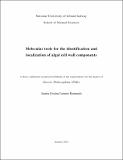| dc.description.abstract | Cell wall glycan-directed monoclonal antibodies (mAbs) are sensitive tools for the detection of wall components in vitro (glycome profiling) and in situ (immunolocalization). Although extensively applied to land plant and green microalgal research, their application to seaweeds is rare and mAbs generated against commercially valuable red- (carrageenans) and brown- (sulfated fucans and alginates) seaweed polysaccharides were never made available to the scientific community. Although brown seaweeds are only distantly related to land plants and the other algal groups, the glycome profile of Fucus vesiculosus indicated that several mAbs, belonging to a group that recognizes arabinogalactans (RG-I/AG), bound to extracts and gave distinct in situ labelling patterns. This led to the conclusion that epitopes from structurally different galactans are present and have distinct spatio-temporal distributions within seaweed tissues. The LAMP mAb, generated against laminaran, recognizes a (1,3)--glucan epitope. While it is commonly used for the immunolocalization of callose in plants it has only rarely been applied to brown seaweeds. However, distinct in situ labelling patterns in F. vesiculosus and Laminaria digitata indicate that LAMP is a valuable probe for brown seaweed research. The LM7 mAb recognizes an epitope present in homogalacturonan, localized in land plants to the corners of the intercellular spaces between adherent and separated cell walls. In situ labelling of F. vesiculosus and L. digitata highlight this mAb as an excellent marker for alginates. These results show that some land plant cell wall glycan epitopes are present in brown seaweeds, providing new insights into cell wall evolution. Additionally identification of existing mAbs that can recognize epitopes present in seaweed cell walls has diversified and added valuable additional tools for algal research.
The Vreeland mAbs, generated against seaweed polysaccharides, were tested to see if they remained viable after nearly 40 years storage. Some of the mAb supernatants indeed proved viable and can be used to produce hybridoma lines, creating antibodies for seaweed research.
The green microalga Penium margaritaceum, used as a unicellular model organism for primary cell walls, was shown to be highly sensitive to plant hormones that had severe repercussions for growth and morphology. However, more pertinently, using mAbs, many of the impacts were seen to specifically involve the cell wall. These studies pave the way for future research regarding the restructuring of specific cell wall components, and wall architecture, by hormones as well as investigation of the mode of action of inhibitors. | en_IE |


